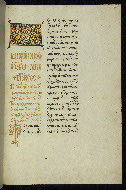Home > Digitized Walters Manuscripts
This document is a tranformation of a TEI P5 XML manuscript description incorporating images. If you have trouble reading special or non-Latin characters on this page, please make sure you have appropriate Unicode fonts installed and an up-to-date web browser.
Walters Ms. W.535, Gospel lectionary
Browse images (Browse images in a new window) | TEI in XML format
W.535
Gospel lectionary
Vernacular: θεῖον καὶ ἱερὸν ἅγιον εὐαγγέλιον
This is one of twenty-six known manuscripts by the hand of Luke the Cypriot (fl. 1583-1625), an accomplished Greek calligrapher who worked after the Ottoman conquest of Constantinople (1453). He copied it in 1594 at his episcopal see of Buzǎu (in Wallachia, now Romania) and soon took it to Moscow, where it was richly illustrated with New Testament scenes by a team of anonymous Russian artists. The book contains passages taken from the four Gospels and arranged in the order in which they are read out loud in church during the course of the year (hence its name of Gospel lectionary, from the Latin "lectio," or reading). Short instructions in Slavonic accompany some of the miniatures, offering a glimpse into the painters' working process.
Text dated June 4, 1594; miniatures added by 1596
Buzǎu, Romania (text); Moscow, Russia (miniatures)
Authority name: Lukas, of Cyprus
As-written name: Luke the Cypriot, bishop of Buzǎu
Name, in vernacular: Λουκᾶς ὁ Κύπριος, ἐπίσκοπος Μπουζέου
Known as: Luke of Cyprus
Book
Liturgical
Scriptural
The primary language in this manuscript is Greek, Ancient (to 1453). The secondary language of this manuscript is Church Slavic; Old Slavonic; Church Slavonic; Old Bulgarian; Old Church Slavonic.
- In vernacular: Ἐτελειώθη τὸ παρὸν θεῖον (καὶ) ἱερὸν ἅγιον εὐαγγέλιον διὰ χειρὸς ἐμοῦ τοῦ ταπεινοῦ (καὶ) εὐτελοὺς ἐπισκόπου Μπουζέου Λουκᾶ τοῦ κυπρίου ἐν ἡμέραις τοῦ εὐσεβεστάτου αὐθεντὸς ἡμῶν Ἰω(άννου) Μηχαὴλ βοεβόντ(α), ἔτει ἀπὸ τῆς ἐνσάρκου οἰκονομίας τοῦ Κ(υρίο)υ ἡμῶν Ἰ(ησο)ῦ Χ(ριστο)ῦ ΑΦϞΔ-ῳ, ἰν(δικτιῶ)νος Ζ, μηνὶ ἰουνίῳ Δ-ῃ, ἡμέρᾳ Γ-ῃ. Οἱ αναγινώσκοντες εὔχεσθε μοι διὰ τὸν Κ(ύριο)ν.
- Transliteration: Eteleiōthē to paron theion (kai) hieron hagion euangelion dia cheiros emou tou tapeinou (kai) eutelous episkopou Mpouzeou Louka tou Kypriou en hēmerais tou eusebestatou authentos hēmōn Iō(annou) Mēchaēl boebond(a), etei apo tēs enasrkou oikonomias tou K(yrio)u hēmōn I(ēso)u Ch(risto)u 1594 in(diktiō)nos 7, mēni iouniō 4ē, hēmer(a) 3ē. Hoi anaginōskontes euchesthe moi dia ton K(yrio)n.
- Translation: The present divine and sacred Holy Gospel was completed by the hand of me, the humble and worthless Luke the Cypriot, bishop of Buzau, in the days of our most pious prince, voivod John Michael, in the year 1594 of the incarnation of our Lord Jesus Christ, indiction 7, June 4, Tuesday. Ye who read this, pray to the Lord for me.
Paper
Folded in folios; chain distance of 31mm; watermarks and countermarks very similar to A. Mareş, Filigranele hîrtei întrebuiţate în ţările române în secolul al XVI-lea (Bucarest, 1987), no. 1006; paper flyleaves with watermarks and countermarks identical to Edward Heawood, Watermarks, Mainly of the 17th and 18th Centuries (Hilversum, Holland: Paper Publications Society), 1950, no. 2222
Foliation: vii+415+iii
Modern foliation in pencil (done by Dorothy Miner) in upper right corners of rectos (followed here); includes flyleaves
Formula: vii, 1-10(8), 11(8,-3), 12-13(8), 14 (8,-4), 15-31(8), 32(8,-3), 33(8), 34(10,-4), 35-38(8), 39(8,-4), 40-44(8), 45(8,-8), 46(8), 47(2), 48-50(8), 51(2,-2), 52(4), 53-54(8), 55(4), iii
Catchwords: None
Signatures: Scribal Greek numerals in dark brown ink in the middle of the lower margin of the first and last folio of each quire (fols. 9r–371v) or in the middle of the lower margin of the first folio of each quire (fols. 372r–419r); να and νβ (51 and 52) repeated twice (fols. 398r–399r, 402r–403r)
Comments: Quires begin on fols. 8(1), 16(2), 24(3), 32(4), 40(5), 48(6), 56(7), 64(8), 72(9), 80(10), 88(11), 95(12), 103(13), 111(14), 118(15), 126(16), 134(17), 142(18), 150(19), 158(20), 166(21), 174(22), 182(23), 190(24), 198(25), 206(26), 214(27), 222(28), 230(29), 238(30), 246(31), 254(32), 261(33), 269(34), 278(35), 286(36), 294(37), 302(38), 310(39), 317(40), 325(41), 333(42), 341(43), 349(44), 357(45), 364(46), 372(47), 374(48), 382(49), 390(50), 398(51), 399(52), 403(53), 411(54), 419(55)
27.0 cm wide by 39.4 cm high
14.5 cm wide by 24.7 cm high
- Columns: 2
- Ruled lines: 21
- Title: Divine and sacred Holy Gospel
- Hand note: Characteristic archaizing calligraphy of Luke the Cypriot, as described in Maria-Despina Zoumbouli, Luc de Buzau et les centres de copie de manuscrits grecs en Modolvalachie (XVIe–XVIIe siècles) (Athens: Comité national grec des études du sud-est européen, 1995), pp. 68–72
- Decoration note: Non-figural ornament by the scribe, Luke the Cypriot; figural miniatures by several anonymous painters; ornamented headpiece and initial at the beginning of sections; gilded initial letters (usually "E" or "T") at the beginning of each pericope; many lections accompanied in the side margin by square figural miniatures of New Testament scenes
- Title: Readings for the weeks of John
- Title: Readings for the weeks of Matthew
- Title: Readings for the weeks of Mark
- Title: Readings for the weeks of Luke
- Title: Readings for Lent
- Title: Readings for the fixed feast days (Menologion)
- Title: Gospel readings for various occasions
fol. 8v:
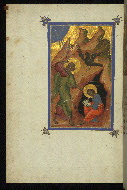
- Title: The Evangelist John receiving divine inspiration and dictating the Gospel to his disciple Prochorus
- Form: Full-page miniature
- Text: Opening of the readings for the weeks of John
- Comment:
The labeling inscriptions read, "ho hag(i)os Iō(annēs) ho Theologos" and "ho hag(i)os Prochorōs," which translate as "St. John the Theologian," and "St. Prochorus." The text in the book held by Prochorus is the beginning of the Gospel of John: "En archē ēn ho logos, kai ho logos ē(n)," or "In the beginning was the Word, and the Word w(as)."
fol. 9r:
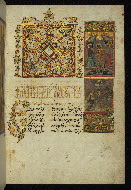
- Title: Ornamented headpiece and initial letter "E," with the Resurrection of Christ and John the Baptist preaching (John 1:6-9)
- Form: Ornament; marginal miniatures
- Text: John 1:1-3 (beginning of the first reading for Easter Sunday)
- Label: The decoration on this page is by two or possibly three different hands. The headpiece, ornamented title, and initial letter "E" are the work of the scribe Luke the Cypriot, while the images and framing ornament in the side margin are by a professional artist(s). (It may be that the images themselves are the work of one painter, and the ornamental frame above and below them, of another).
- Comment:
Because the text on this folio opens the Gospel reading for Easter, it has been illustrated with an image of Christ's Resurrection. The following scene shows John the Baptist (with reference to John 1:6-9 and probably also John 1:15) pointing a group of men to the infant Christ in the bosom of the Father (compare John 1:2).
fol. 10v:
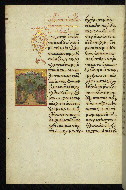
- Title: Christ appearing to his disciples after the Resurrection
- Form: Marginal miniature
- Text: John 20:19-24 (vesperinal reading for Easter Sunday)
fol. 11r:
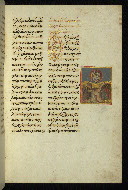
- Title: John the Baptist preaching (John 1:19-20)
- Form: Marginal miniature
- Text: John 20:24-25 (end of the vesperinal reading for Easter Sunday); John 1:18-19 (reading for the Monday after Easter)
- Comment:
The labeling inscriptions are in Slavonic: "G(ospo)d(") Sav(a)ōth(")," "Ioan(")." In translation: "the Lord God of Hosts," "John."
This scene is very similar to the one on fol. 9r. Again, John the Baptist is preaching in the desert. The men whom he addresses are evidently the priests and Levites (John 1:19). He points to "God the only Son, who is close to the Father's heart" (John 1:18).
Even though the text in this volume is in Greek, the miniature here and several others are accompanied by Slavonic inscriptions because they are the work of Russian artists (who most probably did not understand Greek).
fol. 12r:

- Title: Christ on the road to Emmaus; Peter at the empty tomb
- Form: Marginal miniature
- Text: John 1:19-28 (end of the reading for the Monday after Easter); Luke 24:12-13 (reading for the Tuesday after Easter)
- Comment:
The inscription reads, "Pert," the incorrect Slavonic for "Peter."
This image comprises two scenes that illustrate separate events: Luke 24:12 (in the foreground) and Luke 24:15-17 (in the background). The village of Emmaus is in the upper left corner.
fol. 14r:
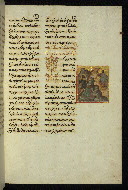
- Title: Christ coming to John the Baptist in the desert
- Form: Marginal miniature
- Text: Luke 24:31-35 (end of the reading for the Tuesday after Easter); John 1:35-37 (reading for the Wednesday after Easter)
fol. 16r:
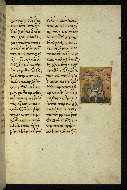
- Title: Christ addressing Nicodemus
- Form: Marginal miniature
- Text: John 3:2-7 (reading for the Thursday after Easter)
- Comment:
Inscribed in Cyrillic, "Nikodim," or "Nicodemus."
The letter "B" in the lower margin is the signature for the second quire of the manuscript.
fol. 17r:
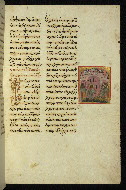
- Title: Christ driving the merchants from the Temple
- Form: Marginal miniature
- Text: John 3:14-15 (end of the reading for the Thursday after Easter); John 2:12-15 (reading for the Friday after Easter)
fol. 18r:
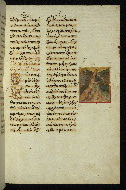
- Title: Christ and John the Baptist baptizing
- Form: Marginal miniature
- Text: John 2:22 (end of the reading for the Friday after Easter); John 3:22-26 (reading for the Saturday after Easter)
- Comment:
This image illustrates the beginning of the lection John 3:22-23.
fol. 19r:
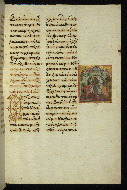
- Title: Doubting Thomas
- Form: Marginal miniature
- Text: John 3:32-33 (end of the reading for the Saturday after Easter); John 20:19-21 (reading for the first Sunday after Easter)
fol. 20r:
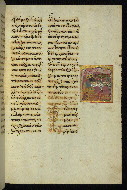
- Title: Wedding at Cana
- Form: Marginal miniature
- Text: John 20:27-31 (end of the reading for the first Sunday after Easter); John 2:1 (reading for the second Monday after Easter)
fol. 26r:
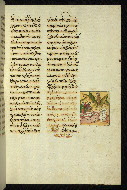
- Title: Women at the Tomb
- Form: Marginal miniature
- Text: John 6:22-27 (end of the reading for the second Saturday after Easter); title and introductory phrase for Mark 15:43 (reading for the third Sunday after Easter)
- Comment:
The inscription in Slavonic reads, "Ned(e)lia mironosits," or "Sunday of the myrrh-bearing women."
The inscription across the lower frame is not a proper identifying label but rather provides guidance for the artists, who could not read the Greek text. Unlike the preceding miniatures, this one is painted in wash (a sort of watercolor). It is probably the work of a second painter.
fol. 31v:
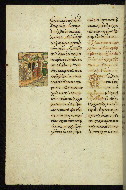
- Title: Healing of the paralytic
- Form: Marginal miniature
- Text: John 15:25-16:2 (end of the reading for the third Saturday after Easter); John 5:1-2 (reading for the fourth Sunday after Easter)
- Comment:
The inscription in Slavonic reads, "Vi(thi)[z]da koupel' G(ospod)' iztseli rosloblenag(o)," or "The Bethesda pool. The Lord healed the paralytic."
This inscription, which is covered now by pigments, was meant as guidance for the painter.
fol. 35r:
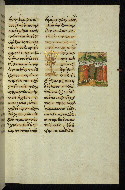
- Title: Christ teaching
- Form: Marginal miniature
- Text: John 7:9-13 (end of the reading for the fourth Tuesday after Easter); John 7:14-16 (reading for mid-Pentecost)
fol. 39r:

- Title: Christ and the Samaritan woman
- Form: Marginal miniature
- Text: John 8:39-42 (end of the reading for the fourth Saturday after Easter); John 4:5 (reading for the fifth Sunday after Easter)
- Comment:
The inscription in Slavonic reads, "Ned(e)lia samariskaia," or "Sunday of the Samaritan woman."
Note that the inscription identifies the feast day to which the image corresponds, rather than the Gospel event it depicts.
fol. 48r:
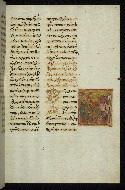
- Title: Healing of the blind man
- Form: Marginal miniature
- Text: John 10:33-38 (end of the reading for the fifth Saturday after Easter); John 9:1-2 (reading for the sixth Sunday after Easter)
fol. 58r:
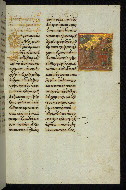
- Title: "Father, the hour has come" (John 17:1)
- Form: Marginal miniature
- Text: John 17:1-6 (reading for the seventh Sunday after Easter)
- Label: From this point on in the manuscript, the miniatures are again painted with gold and tempera; the first painter must have taken over from the second one (who worked in wash).
fol. 67v:
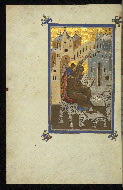
- Title: The Evangelist Matthew writing his Gospel, inspired by Wisdom
- Form: Full-page miniature
- Text: Opening of the readings for the weeks of Matthew
- Comment:
The inscription in Slavonic reads, "dukh," and in Greek, "ho hag(ios) Matthaios." In translation: "spirit," and "Saint Matthew." In the book held by the Evangelist is visible Matthew 1:1-2 (text in Greek).
Personifications of Wisdom as an angel whispering into the ear of an Evangelist are common in East Christian art of the fourteenth and later centuries.
fol. 68r:
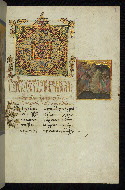
- Title: Ornamented headpiece and initial letter "E" with the parable of the lost sheep
- Form: Marginal miniature
- Text: Matthew 18:10 (reading for the first Monday after Pentecost)
fol. 73r:
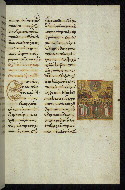
- Title: All Saints
- Form: Marginal miniature
- Text: Matthew 5:46-48 (end of the reading for the first Saturday after Pentecost); Matthew 10:32-33.37-38, 19:27 (reading for the first Sunday after Pentecost)
- Comment:
The inscription in the book held by Christ reads, in Slavonic, "Ne na litsa." The inscription in the scroll held by John the Baptist reads, also in Slavonic, "Agnets" Bozhii zia(shchii)." In translation: "Not according to appearances," (John 7:24) and "The lamb of God taking" (John 1:29).
The first Sunday after Pentecost is celebrated as the Sunday of All Saints, hence the subject of the miniature.
fol. 77r:
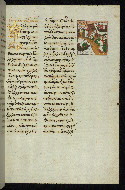
- Title: Christ healing the sick; the calling of Peter and Andrew; the calling of James and John
- Form: Marginal miniature
- Text: Matthew 4:18-22 (reading for the second Sunday after Pentecost)
- Label: On this folio, the painting technique again changes from tempera to wash.
- Comment:
The scene of Christ healing the sick illustrates the last verse of the reading (Matthew 4:23), found on the following folio, fol. 77v.
fol. 82r:
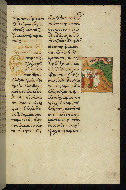
- Title: "Look at the birds of the air" (Matthew 6:26)
- Form: Marginal miniature
- Text: Matthew 8:4 (end of the reading for the third Saturday after Pentecost); Matthew 6:22-25 (reading for the third Sunday after Pentecost)
fol. 87r:
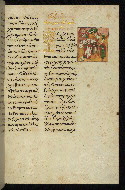
- Title: Christ healing the centurion's servant
- Form: Marginal miniature
- Text: Matthew 8:20-23 (end of the reading for the fourth Saturday after Pentecost); Matthew 8:5-8 (reading for the fourth Sunday after Pentecost)
fol. 92r:
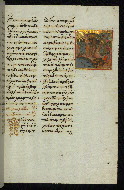
- Title: Christ exorcising the demoniacs
- Form: Marginal miniature
- Text: Matthew 9:11-13 (end of the reading for the fifth Saturday after Pentecost); Matthew 8:28-31 (reading for the fifth Sunday after Pentecost)
fol. 98r:
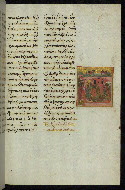
- Title: Healing of the man with palsy
- Form: Marginal miniature
- Text: Matthew 9:2-8 (reading for the sixth Sunday after Pentecost)
fol. 102v:
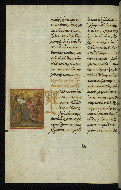
- Title: Christ healing two blind men
- Form: Marginal miniature
- Text: Matthew 10:42-11:1 (end of the reading for the seventh Saturday after Easter); Matthew 9:27-31 (reading for the seventh Sunday after Pentecost)
fol. 107r:
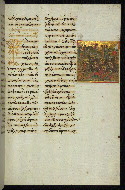
- Title: Feeding of the five thousand
- Form: Marginal miniature
- Text: Matthew 12:37 (end of the reading for the eighth Saturday after Pentecost); Matthew 14:14-19 (reading for the eighth Sunday after Pentecost)
fol. 113r:
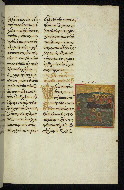
- Title: Christ walking on water with Peter
- Form: Marginal miniature
- Text: Matthew 15:34-39 (end of the reading for the ninth Saturday after Pentecost); Matthew 14:22 (reading for the ninth Sunday after Pentecost)
- Comment:
The inscription above the frame reads, in Slavonic, "G(o)s(pod)' khode(t) po morie s Pe(t)rom(")," and above Peter's head, in Slavonic, "apostol Pe(t)r." This translates as: "The Lord walks upon the sea with Peter," and "the Apostle Peter."
Jesus Christ is depictied twice, representing two separate stages in the story.
fol. 125r:
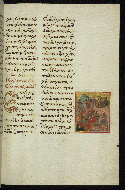
- Title: Parable of the talents
- Form: Marginal miniature
- Text: Matthew 19:12 (end of the reading for the eleventh Saturday after Pentecost); Matthew 18:23-26 (reading for the eleventh Sunday after Pentecost)
fol. 129v:
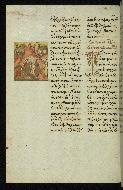
- Title: Christ and the rich man who was seeking eternal life
- Form: Marginal miniature
- Text: Matthew 20:30-34 (end of the reading for the twelfth Saturday after Pentecost); Matthew 19:16-17 (reading for the twelfth Sunday after Pentecost)
fol. 134v:
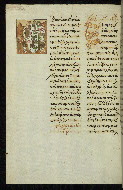
- Title: Parable of the wicked husbandmen
- Form: Marginal miniature
- Text: Matthew 22:19-22 (end of the reading for the thirteenth Saturday after Pentecost); Matthew 21:33-34 (reading for the thirteenth Sunday after Pentecost)
fol. 142r:
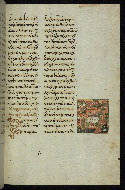
- Title: Parable of the king's wedding
- Form: Marginal miniature
- Text: Matthew 23:9-12 (end of the reading for the fourteenth Saturday after Pentecost); Matthew 22:2-4 (reading for the fourteenth Sunday after Pentecost)
fol. 148v:
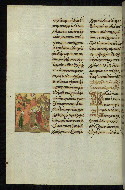
- Title: Christ addressing the Pharisees about the great commandment
- Form: Marginal miniature
- Text: Matthew 24:7-13 (end of the reading for the fifteenth Saturday after Pentecost); Matthew 22:35-36 (reading for the fifteenth Sunday after Pentecost)
fol. 154v:
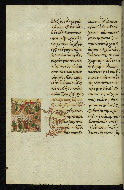
- Title: Parable of the talents
- Form: Marginal miniature
- Text: Matthew 24:43-44 (end of the reading for the sixteenth Saturday after Pentecost); Matthew 25:14-17 (reading for the sixteenth Sunday after Pentecost)
fol. 158v:
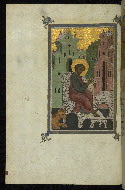
- Title: The Evangelist Luke seated, writing, with his symbol, the calf
- Form: Full-page miniature
- Text: Opening of the readings for the weeks of Luke
- Comment:
The inscription in Greek reads, "ho hag(ios) Loukas," or "Saint Luke." In the book held by the Evangelist, the inscription reads, "Luke 1:1" (in Greek).
fol. 159r:
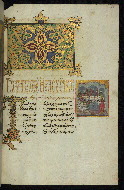
- Title: Ornamented headpiece and initial letter "Pi" with Herod's feast
- Form: Ornamented headpiece; ornamented initial letter; marginal miniature
- Text: Luke 3:19 (reading for the first Monday of the new year)
fol. 169v:
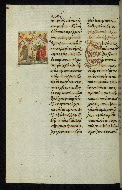
- Title: Christ addressing his disciples
- Form: Marginal miniature
- Text: Luke 5:24-26 (end of the reading for the second Saturday of the new year); Luke 6:31-33 (reading for the second Sunday of the new year)
fol. 174v:

- Title: Christ raising the son of the widow of Nain
- Form: Marginal miniature
- Text: Luke 5:27-32 (reading for the third Saturday of the new year); Luke 7:11 (reading for the third Sunday of the new year)
fol. 179v:
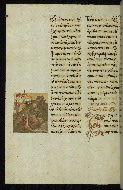
- Title: Parable of the sower
- Form: Marginal miniature
- Text: Luke 6:6-10 (end of the reading for the fourth Saturday of the new year); Luke 8:5 (reading for the fourth Sunday of the new year)
fol. 185r:
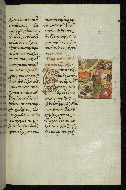
- Title: Parable of the rich man and Lazarus
- Form: Marginal miniature
- Text: Luke 7:7-10 (end of the reading for the fifth Saturday of the new year); Luke 16:19-21 (reading for the fifth Sunday of the new year)
fol. 190r:
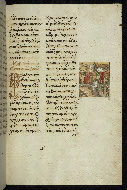
- Title: Christ exorcising the Gadarene demoniacs
- Form: Marginal miniature
- Text: Luke 8:21 (end of the reading for the sixth Saturday of the new year); Luke 8:27-29 (reading for the sixth Sunday of the new year)
fol. 195v:
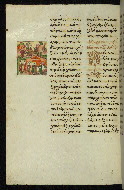
- Title: Healing of the woman with the issue of blood; raising of the daughter of Jairus
- Form: Marginal miniature
- Text: Luke 9:3-6 (end of the reading for the seventh Saturday of the new year); Luke 8:41-42 (reading for the seventh Sunday of the new year)
fol. 201v:
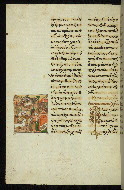
- Title: Parable of the good Samaritan
- Form: Marginal miniature
- Text: Luke 9:39-43 (end of the reading for the eighth Saturday of the new year); Luke 10:25 (reading for the eighth Sunday of the new year)
fol. 207v:
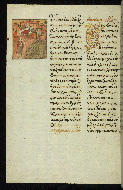
- Title: Parable of the abundant harvest
- Form: Marginal miniature
- Text: Luke 9:60-62 (end of the reading for the ninth Saturday of the new year); Luke 12:16-18 (reading for the ninth Sunday of the new year)
fol. 212r:
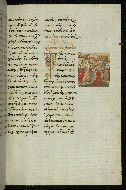
- Title: Christ healing a deformed woman
- Form: Marginal miniature
- Text: Luke 10:19-21 (end of the reading for the tenth Saturday of the new year); Luke 13:10-12 (reading for the tenth Sunday of the new year)
fol. 217r:
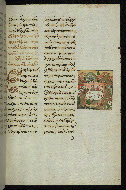
- Title: Parable of the invitation to supper
- Form: Marginal miniature
- Text: Luke 12:40 (end of the reading for the eleventh Saturday of the new year); Luke 14:16-20 (reading for the eleventh Sunday of the new year)
fol. 222r:
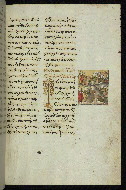
- Title: Christ healing ten lepers
- Form: Marginal miniature
- Text: Luke 13:25-29 (end of the reading for the twelfth Saturday of the new year); Luke 17:12-13 (reading for the twelfth Sunday of the new year)
fol. 226v:
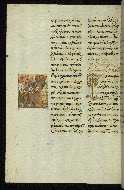
- Title: Christ and the ruler seeking eternal life
- Form: Marginal miniature
- Text: Luke 14:8-11 (end of the reading for the thirteenth Saturday of the new year); Luke 18:18-19 (reading for the thirteenth Sunday of the new year)
fol. 231v:
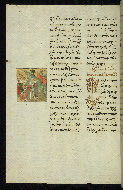
- Title: Christ healing a blind man
- Form: Marginal miniature
- Text: Luke 16:12-15 (end of the reading for the fourteenth Saturday of the new year); Luke 18:35-36 (reading for the fourteenth Sunday of the new year)
fol. 236r:
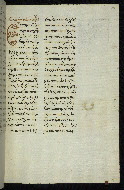
- Title: Christ and Zaccheus
- Form: Unfinished preparatory drawing for a marginal miniature
- Text: Luke 17:3-8 (reading for the fifteenth Saturday of the new year)
- Label: The artist mistakenly started executing the miniature that properly belongs on the following folio, fol. 236v.
fol. 236v:
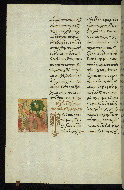
- Title: Christ and Zaccheus
- Form: Marginal miniature
- Text: Luke 17:8-10 (end of the reading for the fifteenth Saturday of the new year); Luke 19:1-5 (reading for the fifteenth Sunday of the new year)
fol. 241v:
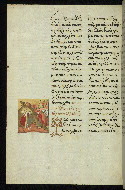
- Title: Christ and the Cananite woman
- Form: Marginal miniature
- Text: Luke 18:6-8 (end of the reading for the sixteenth Saturday of the new year); Matthew 15:21-24 (reading for the sixteenth Sunday of the new year)
fol. 242v:
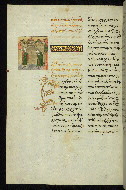
- Title: The publican and the Pharisee
- Form: Marginal miniature
- Text: Luke 18:10-13 (reading for the Sunday of the Publican and the Pharisee)
fol. 247r:
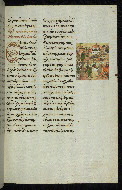
- Title: Parable of the prodigal son
- Form: Marginal miniature
- Text: Matthew 11:15 (end of the reading for the seventeenth Saturday of the new year); Luke 15:11-16 (reading for the seventeenth Sunday of the new year)
fol. 257r:
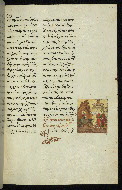
- Title: Christ addressing the apostles
- Form: Marginal miniature
- Text: Luke 21:26-27.33.34-36 (end of the reading for Meatfare Saturday); Matthew 25:31 (reading for Meatfare Sunday)
fol. 268v:
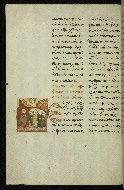
- Title: Christ addressing the apostles; God the Father in heaven
- Form: Marginal minaiture
- Text: Matthew 6:12-13 plus doxology (the Lord's Prayer) (end of the reading for Cheesefare Saturday); Matthew 6:14-17 (reading for Cheesefare Sunday)
fol. 272v:
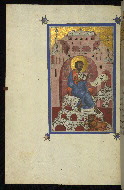
- Title: The Evangelist Mark with his symbol, the lion
- Form: Full-page miniature
- Text: Opening of the readings for Lent
- Comment:
The inscription above Mark's head reads, in Greek: "Ho hag(ios) Markos," or "Saint Mark." The inscription on the scroll before the Evangelist and in the book held by him reads: "Mark 1:1," in Greek.
fol. 273r:
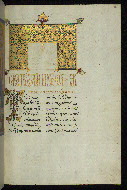
- Title: Ornamented headpiece and initial letter "T"
- Form: Decorated headpiece; decorated initial
- Text: Mark 2:23-25 (reading for the first Saturday of Lent)
fol. 278r:
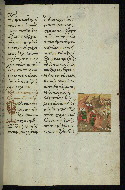
- Title: Christ addressing the apostles; Christ exorcising a demoniac
- Form: Marginal miniature
- Text: Mark 7:36-37 (end of the reading for the fourth Saturday of Lent); Mark 9:17-19 (reading for the fourth Sunday of Lent)
fol. 280r:
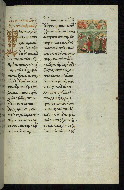
- Title: Christ, James, and John talking; Christ addressing the apostles
- Form: Marginal miniature
- Text: Mark 10:32-37 (reading for the fifth Sunday of Lent)
fol. 281r:
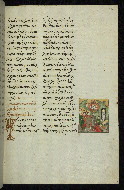
- Title: Raising of Lazarus
- Form: Marginal miniature
- Text: Mark 10:43-45 (end of the reading for the fifth Sunday of Lent); John 11:1-4 (reading for Lazarus Sunday)
fol. 285r:
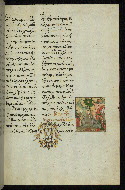
- Title: Entry into Jerusalem
- Form: Marginal miniature
- Text: Matthew 21:9-17 (end of the reading for matins on Palm Sunday); John 12:1 (reading for the liturgy on Palm Sunday)
fol. 374r:
The binding is original.
Dates to the end of the sixteenth century; pasted down by Liz Bentzel in May 1935; patterned red silk over squared wooden boards; spine raised with six bands; traces of now lost metal attachments and clasps; pastedowns of yellow silk
Church of the Holy Sepulcher, Jerusalem, ca. 1598, by gift
Léon Gruel, Paris, by purchase
Henry Walters, Baltimore, purchased from Gruel before 1931
Walters Art Museum, 1931, by Henry Walters bequest
Papadopoulos-Kerameus, Athanasios. Hierosolymitikē vivliothēkē hētoi katalogos tōn en tais vivliothēkais tou hagiōtatou apostolikou te kai katholikou orthodoxou patriarchikou thronou tōn Hierosolymōn kai pasēs Palaistinēs apokeimenōn hellēnikōn kōdikōn. St. Petersburg, 1897; reprinted Brussels: Culture et civilisation, 1963, vol. 3: 199-200, no. 4.
Gregory, Caspar René. Textkritik des Neuen Testaments. Leipzig, 1909, vol. 1: 460, no. 1029.
Clark, Kenneth Willis. A Descriptive Catalogue of Greek New Testament Manuscripts in America. Chicago: University of Chicago Press, 1937, pp. 367–71, pl. 72.
Miner, Dorothy. “More about Medieval Pouncing.” In Homage to a Bookman: Essays on Manuscripts, Books, and Printing Written for Hans P. Kraus on his 60th Birthday. Edited by H. Lehmann-Haupt. Berlin: Mann, 1967, pp. 87–107, esp. 101–6.
Vikan, Gary. “Walters Lectionary W.535 (A.D. 1594) and the Revival of Deluxe Greek Manuscript Production after the Fall of Constantinople.” In The Byzantine Tradition after the Fall of Constantinople. Edited by J. J. Yiannis. Charlottesville, VA: University Press of Virginia, 1991, pp. 181–268.
Džurova, A. “Le synthèse slavo-byzantine dans les manuscrits grecs dits de “grande luxe,” créés en Valachie et en Moldavie aux XVIe–XVIIe siècles.” In The Greek Script in the 15th and 16th Centuries. Athens: Institute for Byzantine Research, 2000, pp. 499–521.
Parpulov, Georgi R. “A Catalogue of the Greek Manuscripts of the Walters Art Museum.” Journal of the Walters Art Museum 62 (2004): 71-189, esp. 132-140.
Principal cataloger: Parpulov, Georgi R.
Cataloger: Walters Art Museum curatorial staff and researchers since 1934
Editors: Herbert, Lynley; Noel, William
Copy editor: Bockrath, Diane
Conservators: Owen, Linda; Quandt, Abigail
Contributors: Bockrath, Diane; Emery, Doug; Noel, William; Tabritha, Ariel; Toth, Michael B.
The Walters Art Museum
Licensed for use under Creative Commons Attribution-NonCommercial-ShareAlike 3.0 Unported Access Rights, http://creativecommons.org/licenses/by-nc-sa/3.0/legalcode. It is requested that copies of any published articles based on the information in this data set be sent to the curator of manuscripts, The Walters Art Museum, 600 North Charles Street, Baltimore MD 21201.
